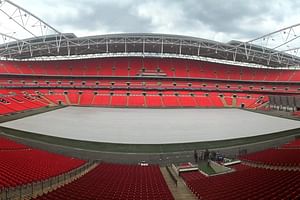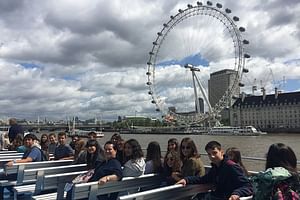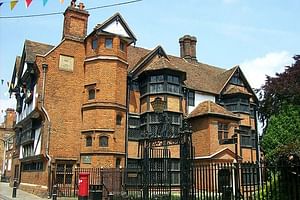Spice up your London experience during your stay in this 2000-year-old city with The Ghost Bus Tour. We will pick you up from your hotel and our tour starts at that moment. Take a ride to the dark side on an elegantly refurbished vintage double-decker where a creepy conductor tells stories from London’s murky past as a city of execution, murder and haunting, of unmarked burial grounds, and all of London’s skeletons from the closet. The tour offers a sightseeing show with actors and onboard technical trickery to give you a fabulous spooky experience. You will encounter all of the top attractions of London, including The Houses of Parliament, London Bridge, Westminster Abbey, Downing Street, Tower Bridge, St. Paul’s Cathedral and The Tower of London. Whether you are a tourist visiting London or a resident of the city, there is so much that will surprise you about the haunted history of London’s most famous attractions. Hop on!
Duration
The tour starts at
-
Ghost Way: The Houses of Parliament, known also as the Palace of Westminster is where the two Houses of the Parliament of the United Kingdom (the House of Lords and the House of Commons) conduct their...
Ghost Way: The Houses of Parliament, known also as the Palace of Westminster is where the two Houses of the Parliament of the United Kingdom (the House of Lords and the House of Commons) conduct their sittings. They lie on the north bank of the River Thames in the London borough of the City of Westminster, close by other government buildings in Whitehall. The oldest part of the building is still in existence, Westminster Hall, which dates from 1097.The palace originally served as a royal residence, but no monarch has lived in it since the 16th century. Most of the present Houses of Parliament structure dates from the 19th century, when the Palace was rebuilt after it was almost entirely destroyed by a fire in 1834. The architects responsible for rebuilding the Palace was Sir Charles Barry and Augustus Welby Pugin, and the building is an example of the Gothic revival. How about ghosts? All are on the tour, jump on.
-
London Bridge should be the best venue in London's haunted history. Wonder why? Well, you'll realize that on this tour. London Bridge is a bridge over the River Thames, between the City of London and ...
London Bridge should be the best venue in London's haunted history. Wonder why? Well, you'll realize that on this tour. London Bridge is a bridge over the River Thames, between the City of London and Southwark. It is between Cannon Street Railway Bridge and Tower Bridge; it also forms the western end of the Pool of London. The original London Bridge made this one of the most famous bridge emplacements in the world. It was the only bridge over the Thames in London until Westminster Bridge was opened in 1750. On the south side of London Bridge is Southwark Cathedral and London Bridge station. On the north side is the Monument to the Great Fire of London and Monument tube station.
A bridge has existed at or near the present site for nearly 2000 years. The first bridge across the Thames in the London area was built by the Romans on the present site around 46 CE and was made of wood. The location was most likely chosen as a bridgeable spot which still had deepwater access to the sea. The bridge fell into disrepair after the Romans left, but at some point either it was repaired or a new timber replacement constructed, probably more than once. In 1013, the bridge was burned down by King Ethelred in a bid to divide the invading forces of the Dane Svein Haraldsson.
This episode reputedly inspired the well-known nursery rhyme London Bridge is falling down. The rebuilt London Bridge was destroyed by a storm in 1091 and yet again, this time by fire, in 1136. The current London Bridge was constructed by contractors John Mowlem from 1967 to 1972 and opened by Queen Elizabeth II on March 17, 1973. London Bridge is a fairly dull edifice comprising three spans of pre-stressed concrete cantilevers, paid for in part by the sale of the earlier Rennie bridge. It is 928 feet (283 metres) long. The cost of £4m was met entirely by the City of London's Bridge House Estates. The current bridge was built in the same location as Rennie's bridge, which was carefully demolished piece by piece as the new bridge was built, so the bridge would remain in use throughout.
In 1984 the British warship HMS Jupiter collided with London Bridge causing significant damage to both ship and bridge. On Remembrance Day 2004, various London bridges were furnished with red lighting as part of a night-time flight along the river by wartime aircraft. The red lighting on London Bridge considerably improved its drab appearance, so it has been left on the bridge (but not the other bridges) and lights it at night.
-
Ghost Way: Westminster Abbey is a Church, burial ground, coronation site and much more and continues to attract visitors over 900 years after its founding. In many respects the architecture is common....
Ghost Way: Westminster Abbey is a Church, burial ground, coronation site and much more and continues to attract visitors over 900 years after its founding. In many respects the architecture is common. There's the traditional cross-shaped floor plan with a nave, north and south transepts and several round side areas but both its execution and use raise The Collegiate Church of St Peter, Westminster (the official name) to among the highest examples of church construction. Here at Westminster Abbey lie buried kings and poets, scientists and philosophers who have themselves raised humankind to the highest levels. Isaac Newton and James Clerk Maxwell (discoverer of electromagnetic theory, which later leads to radio and TV), Chaucer and Kipling, Dr Samuel Johnson (creator of the first English dictionary) and many other justly famous names are interred here. The best location for ghosts.
-
Ghost Way: Tower Bridge is probably the city's most distinctive symbol of today. The Bridge shows a lot to its medieval predecessor London Bridge with its starlings and elaborate twin towers that give...
Ghost Way: Tower Bridge is probably the city's most distinctive symbol of today. The Bridge shows a lot to its medieval predecessor London Bridge with its starlings and elaborate twin towers that give the bridge its name but it's not just a homage to the past, hidden inside that medieval-looking exterior there's a rather wonderful piece of Victorian engineering and in its day it was the biggest and most sophisticated lifting bridge in the world. Unlike London Bridge, the genius of the design is that the bridge can act as a gateway swinging open to allow tall ships to pass through. Listen to the ghost stories from the staff.
-
Ghost Way: Tower Bridge is probably city's most distinctive symbol for today. Bridge shows a lot to its medieval predecessor London Bridge with its starlings and elaborate twin towers that give the br...
Ghost Way: Tower Bridge is probably city's most distinctive symbol for today. Bridge shows a lot to its medieval predecessor London Bridge with its starlings and elaborate twin towers that give the bridge its name but it's not just a homage to the past, hidden inside that medieval looking exterior there's a rather wonderful piece of Victorian engineering and in its day it was the biggest and most sophisticated lifting bridge in the world. Unlike London Bridge, the genius of the design is that the bridge can act as a gateway swinging open to allow tall ships to pass through. Listen to the ghostly stories of Tower Bridge from the staff
-
Ghost Way: St Paul's Cathedral is a cathedral on Ludgate Hill, in the City of London, and the seat of the Bishop of London. The present building dates from the 17th century and is generally reckoned t...
Ghost Way: St Paul's Cathedral is a cathedral on Ludgate Hill, in the City of London, and the seat of the Bishop of London. The present building dates from the 17th century and is generally reckoned to be London's fourth St Paul’s Cathedral, although the number is higher if every major medieval reconstruction is counted as a new cathedral. The first cathedral was built of wood by the Saxons. It burned down in AD 675 and was rebuilt, again in wood, ten years later. After this version was sacked by the Vikings in 962, the "second" St Paul’s was built, this time mainly in stone. The predecessor to Wren's cathedral, the third St Paul’s (known as Old St Paul’s), was begun by the Normans after the late Saxon cathedral suffered in a fire of 1087. Work took over two hundred years, and a great deal was lost in a fire in 1136. Nonetheless, the roof was once more built of wood, which was ultimately to doom the building. St Paul is the symbol of a nation's resistance. Listen to the stories from the Ghost bus staff.
-
Ghost Way: Few prisons can claim to be as popular as the Tower of London, an attraction - unpleasant for some - for over 900 years. Its twenty towers are filled with an ancient tradition of royal bloo...
Ghost Way: Few prisons can claim to be as popular as the Tower of London, an attraction - unpleasant for some - for over 900 years. Its twenty towers are filled with an ancient tradition of royal blood, armor and jewels and the history to match. The Tower of London central structure began as a fort - used by the original builder William the Conqueror who completed the first tower around 1100 AD. At its completion it was the tallest building in London. Henry III had it whitewashed in the 13th century and the name, White Tower, has stuck. Later it evolved into a prison, used by Henry VII (and many others). Still later - and continuing to this day - it has acted as a repository for the extensive collection of crown jewels. Henry VII, nearly always short of money, had few jewels to store. But the stone complex, near the Tower Bridge alongside the River Thames, has also been used at various times to house the Royal Mint, the Public Records, the Royal Menagerie (later to form the starting point of the London Zoo) and an observatory (built-in 1675). Listen to the rest of the story from the Ghost Bus staff.
Lunch
Dinner
Ghost Bus Tour experience tickets

















